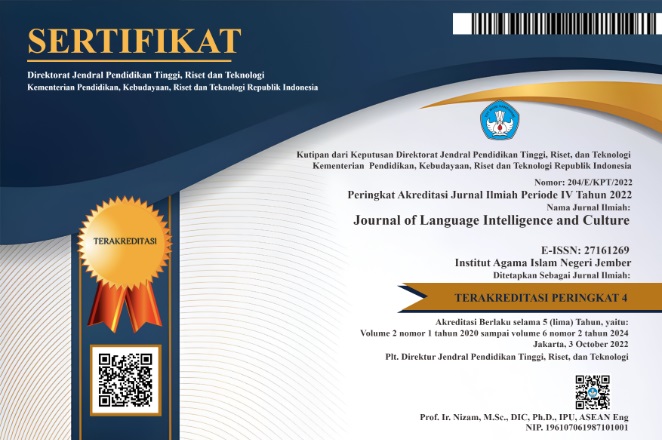Teachers’ Strategy to Develop Higher Order Thinking Skills in Reading Class
DOI:
https://doi.org/10.35719/jlic.v3i2.59Keywords:
Teaching strategy, higher order thinking skills, reading classAbstract
This research aims to find out the strategies used by the teachers and the inhibiting factors that can influence the development of HOTS in Reading Class. It applied qualitative approach with case study research design. The subject of the research were two English teachers of Senior High School. The techniques of collecting the data were used observation and interview. The data were analyzed using the qualitative method there are data reduction, data display, and drawing conclusions. The finding of the research shows that there were 5 types of teaching strategies, including informing learning objectives, divergent questions, group discussion, giving feedback and giving motivation. The most dominant strategy used by the teacher was divergent question. Meanwhile, the learning objective and group discussion was the least prominent, with only 3 data. Then, five inhibiting process such as time, pupil learning ability, pupil’s mastery, planning domain, and class environment can influence the development of HOTS.
References
Aloqaili, A. S. (2012). The relationship between reading comprehension and critical thinking?: A theoretical study. Journal of King Saud University - Languages and Translation, 24(1), 35–41. https://doi.org/10.1016/j.jksult.2011.01.001
Anderson, L.W., Krathwohl, D.R. (2001). A Taxonomy of Learning, Teaching, and Assessing: A Revision of Bloom’s Taxonomy of Educational Objectives. New York: Longman
Ary, Donald., Jacobs, L. C., & Sorensen, Christine. (2010). Introduction to Research in Education. Canada: Wadsworth Cengage Learning.
Bhushan, R. (2014). Developing Learner’s Critical Thinking and Motivation. International Journal on Studies in English Language and Literature (IJSELL), 2(6), 11–16. Retrieved from www.arcjournals.org
Brookhart, S. M. (2010). How to assess higher-order thinking skills in your classroom. Alexandria, Virginia: ASCD. Retrieved from www.ascd.org
Burt, M., Peyton, J. K., Linguistics, A., States U., & Adams, R. J. (2003). Reading and Adult English Language Learners: A Review of the Research. Washington, DC: Center for Applied Linguistics.
Cresswell, John W. (2012). Educational Research. University of Nebraska, Lincoln.
Day, R., & Bamford, J. (2002). Top Ten Principles for Teaching Extensive Reading. Reading in a Foreign Language, 14(2), 136.
Emzir. (2010). Metode Penelitian Kualitatif: Analisis Data. Jakarta:Rajawali Pres.
Grabe, W. (2010). Fluency in Reading — Thirty-Five Years Later. Reading in a Foreign Language, 22(1), 71–83.
Hung, S. Durciknova, A., Lai, H., & Lin, W. (2011). The Influence of Intrinsic and Extrinsic Motivation on Individuals’ Knowledge Sharing Behavior. Journal of Human Computer Studies, 69(6), 415-427. Retrieved from https://doi.org/10.1016/j.ijhcs.2011.02.004.
Limbach, B., & Waugh, W. (2010). Developing Higher Level Thinking. Journal of Instructional Pedagogies, 9. Retrieved February 2018 from https://aabri.com/manuscripts/09423.pdf
Marina, L., Acosta, E., & Ferri, M. M. (2015). Reading strategies to develop higher thinking skills for reading comprehension. Profile Issues in Teachers Professional Development, 12(1), 107–123.
Maulidina, H. (2020). Teacher’s Strategies to Enhance Students’ Higher Order Thinking Skills in Teaching Reading to The Seventh Grade Students of SMP Al-Islam 1 Surakarta. Unpublished Thesis. English Language Education Cultures and language Faculty The State Islamic Institute of Surakarta.
Miles, M.B. & Huberman, M.A. (2014). Qualitative Data Analysis: A Methods Sourcesbooks 3th Ed. Thousand Oaks: SAGE Publications Inc.
Nuary, C. (2015). The Implementation of Discussion in Teaching Reading at Seventh Grade of SMP Murni 1 Surakarta. Unpublished Thesis. English Language Education Cultures and language Faculty Muhammadiyah Surakarta University.
Pasutri, N.S. (2020). Teachers’ Strategy And Challenges In Teaching Higher-Order Thinking Skills In The Rural Area: A Case Study At Junior High School In Gaung District, Inhil, Riau. Unpublished Thesis. English Language Education Cultures and language Faculty Muhammadiyah Surakarta University.
Retnawati, Heri et al. (2018). Teachers Knowledge about Higher Order Thinking Skills and its Learning Strategy. Problem in Education in the 21th Century; vol. 76 no. 2.
Samelian, L. A. (2017). How Higher Order Questioning and Critical Thinking Affects Reading Comprehension (Hamline University). Retrieved from http://digitalcommons.hamline.edu/hse_all
Siswanti, F., & Setyaningsih, N. (2012). The Use of Small-Group Discussion to Improve Students’ Reading Comprehension. English Education, 2(2), 216- 232.
Suryani, W. (2019). Teacher’s Strategies in Teaching Reading to Students’ Eight Grade at Madrasah Tsanawiyah Tarbiyatus Sholihin Muaro Jambi. Unpublished Thesis. English Education Department. Education Faculty and Teacher Training The State Islamic University Sulthan Thaha Saifudin Jambi.
Thomas, A., and Thorne, G., (2009). How to Increase Higher Order Thinking. Metarie, LA: Center for Development and
Learning. Retrieved Sept. 10, 2020, from http://www.cdl.org/resourcelibrary/articles/HOT.php?type=subject&id=18.
Wright, Lesley. (1987). Physical Education and Moral Development. Journal of Philosophy of Education, 2(1). Retrieved from https://doi.org/10.1111/j.1467-9752.1987.tb00146.x.
Downloads
Published
How to Cite
Issue
Section
License
Copyright (c) 2021 Journal of Language Intelligence and Culture

This work is licensed under a Creative Commons Attribution-ShareAlike 4.0 International License.













